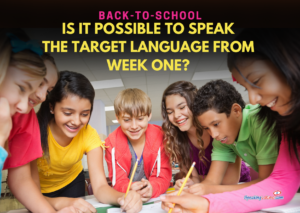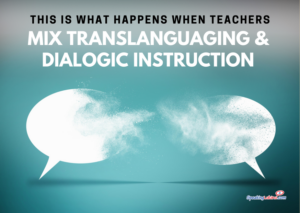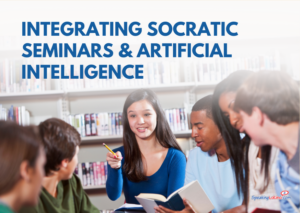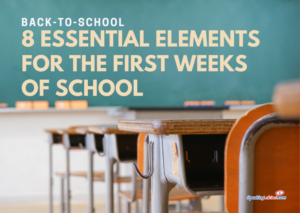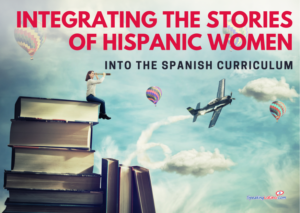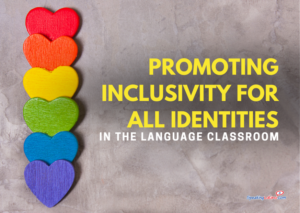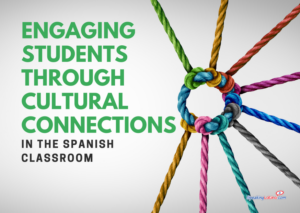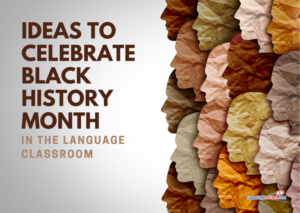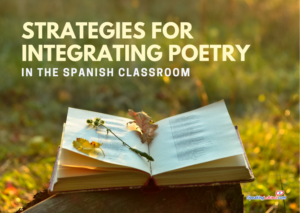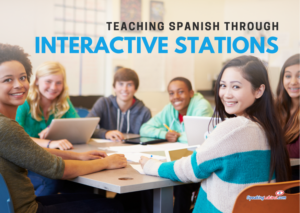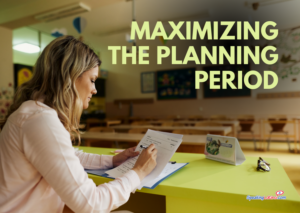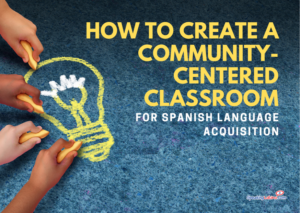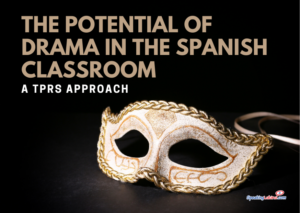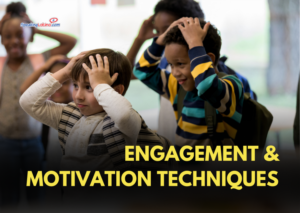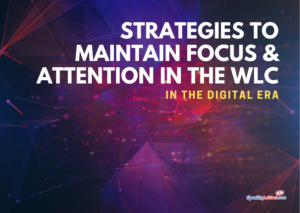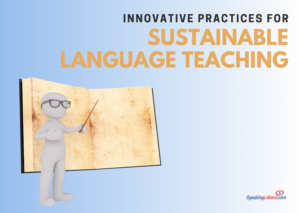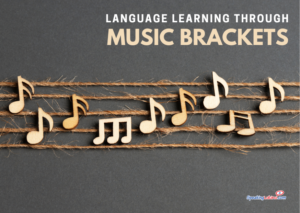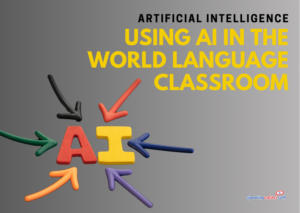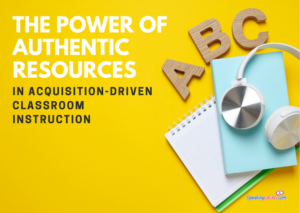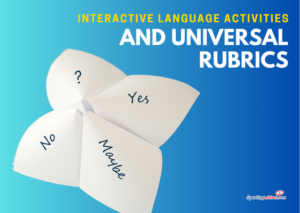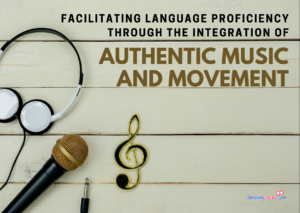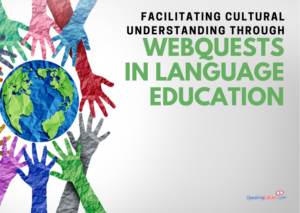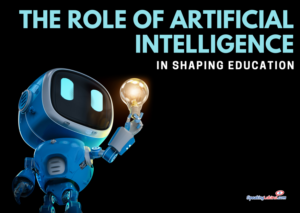Setting the stage for active and engaged learning in world language classes from the moment students enter the classroom is crucial. The first few minutes of class present a unique opportunity to captivate student interest and set the tone for the rest of the session.
Language Teaching Methods
Embark on a transformative journey within your language classroom, where innovation meets efficiency and engagement thrives.
Energize your teaching arsenal with innovative techniques tailored to captivate and inspire students, fostering a deep connection to the rich tapestry of languages and cultures. Supercharge student engagement, fostering an environment where learning flourishes and boundaries are transcended.
Back-To-School: Is it Possible to Speak the Target Language from Week One?
The transition back to school is an opportune time for educators to cultivate an environment that encourages language immersion and strengthens students’ verbal skills.
Emphasizing the importance of speaking in the target language from the first week of classes instills habits that will benefit students throughout the academic year. Discover the methods and philosophies that promote student engagement and language acquisition from the outset.
When Teachers Mix Translanguaging and Dialogic Instruction in the WL Classroom
When teachers mix translanguaging and dialogic instruction in the classroom, it’s like turning up the volume on student engagement, critical thinking, and empathy. By giving students the green light to use all their languages and really dig into analyzing texts, teachers create a totally different classroom vibe.
Students can chat away in different languages, it’s not just about learning words—it’s about flexing their brain muscles in all sorts of ways. They’re diving deep into texts, picking them apart, and putting them back together again.
Making Language Stick with Total Physical Response (TPR)
Language learning doesn’t have to be a grind of rote memorization. Imagine a classroom where students are actively moving, engaged, and picking up new words almost as naturally as they did when they were toddlers!
It’s entirely possible with Total Physical Response (TPR), a brain-compatible strategy that not only deepens learner engagement but also ensures the long-term retention of language skills.
11 Teaching Techniques Proven to Make the World Language Classroom More Fun
In language education, using a mix of different methods is key to boosting understanding and keeping students interested. Trying out various teaching techniques gives educators plenty of options to create engaging and effective lessons.
Today, we’ll look at eleven teaching methods, each designed to meet different learning styles and goals. Diving into language learning isn’t just about memorizing vocab and getting the grammar right—it’s also about making the process engaging and fun!
Integrating Socratic Seminars and Artificial Intelligence
The way we teach advanced language and literature classes is changing a lot, thanks to more interactive and engaging methods. One standout approach is the Socratic Seminar, which really helps students dive deep into literary analysis.
Socratic Seminars are even more impactful when combined with the strategic use of artificial intelligence (AI), enhancing both the preparation and execution of educational activities within the classroom.
Digital Organization Mastery for Teachers
A well-structured digital organization system not only saves precious time but also enhances productivity, allowing you to focus on their core responsibilities.
Let’s explore practical approaches and tools that can be utilized to set up a personalized, streamlined digital organization system that caters to individual needs and preferences.
The initial weeks determine the trajectory of the students’ educational experience and are integral to laying a foundation that fosters academic proficiency and productive classroom habits.
8 Essential Elements for the First Weeks of School
As the starting whistle of a new academic year sounds, educators are presented with a golden window to cultivate an atmosphere of learning, respect, and community in their classrooms. It’s a time that requires foresight and deliberate action.
The initial weeks determine the trajectory of the students’ educational experience and are integral to laying a foundation that fosters academic proficiency and productive classroom habits.
Integrating the Stories of Hispanic Women into the Spanish Curriculum: Women’s History Month
The importance of diversity and inclusion in the classroom cannot be overstated. A comprehensive Spanish curriculum that celebrates the contributions of Hispanic women not only enriches students’ learning experience but also serves as a powerful tool for empowerment and combating stereotypes.
Promoting Inclusivity for All Identities in the Language Classroom
Let’s discuss the various facets of including queer identities in language education, exploring the resistance encountered and advocating for strategies that uphold linguistic liberation and LGBTQ+ inclusivity.
Engaging Students Through Cultural Connections in the Spanish Classroom
When educators blend culture and language learning seamlessly, they not only enrich the learning environment but also encourage a profound, empathetic understanding of diversity among students.
Ideas to Celebrate Black History Month in the Language Classroom
The integration of Black History Month themes offers a unique opportunity to celebrate diversity, explore social justice issues, and highlight the contributions of the African diaspora. By incorporating a range of resources and activities, educators can create an immersive and inclusive learning environment that reflects the cultural and ethnic diversity of students today.
Strategies for Integrating Poetry in the Spanish Classroom
Comprehensible poetry strips away the barriers that often render classical literary texts intimidating for language learners. By offering poetry written with familiar vocabulary and structures, educators help students navigate new linguistic landscapes with confidence.
Teaching Spanish Through Interactive Stations
Explore various station-based activities and games designed specifically for language learning and analyze their impact on vocabulary, grammar, reading, writing, comprehension, and conversational skills.
10 Ways to Maximize the Teacher Planning Period and Achieving Work-Life Balance
By implementing strategies such as setting priorities, utilizing self-grading methods, creating boundaries, and seeking support, teachers can enhance productivity, reduce workload, and prevent burnout.
How to Create a Community-Centered Classroom for Spanish Language Acquisition
The pursuit of language proficiency in educational settings often revolves around the challenge of creating an environment conducive to natural language acquisition. A pivotal factor in this quest is the understanding that learning thrives within a community-oriented approach paired with engaging methodologies.
The Potential of Drama in the Spanish Classroom: A TPRS Approach
Utilizing drama within a Teaching Proficiency through Reading and Storytelling (TPRS) framework elevates the traditional language learning experience by integrating creativity, context, and cognates into the curriculum, fostering deeper understanding and retention.
8 Engagement and Motivation Techniques for the Spanish Classroom
By utilizing a variety of teaching strategies such as games, movement activities, and interactive routines, Spanish teachers can create an emotionally engaging and intellectually stimulating environment that promotes language acquisition and cultural appreciation.
Embracing Diversity and Challenging Biases in the World Language Classroom
In an increasingly diverse and interconnected world, the language classroom has become a critical arena for promoting equity and challenging biases. This has necessitated a shift in pedagogical approaches to ensure that teaching methods are inclusive and reflective of the complexities of gender, race, and culture.
Strategies to Maintain Focus and Attention in the World Language Classroom in the Digital Era
In the digital era, the infusion of technology into our daily lives has reshaped the way we engage with the world—including how we learn languages.
5 Innovative Practices for Sustainable Language Teaching
Explore the principles and practices necessary for establishing a sustainable language teaching framework.
Genial.ly: The Best AI for Visual Storytelling
Through the power of tools like Genial.ly and Canva, language educators are now equipped to craft engaging and dynamic narratives that captivate the curiosity of learners and make the educational journey both fun and effective.
Language Learning Through Music Brackets
Explore the versatile approach of music brackets in language classrooms, underscoring their efficacy in fostering engagement, enhancing cultural appreciation, and strengthening language competencies.
Cultivating Inclusivity and Diversity in the Spanish Classroom
Explore the transformative practices that are essential for promoting a more inclusive, accurate, and engaging Spanish classroom.
This Is How Teachers Are Using Artificial Intelligence in the World Language Classroom
Learn about various AI tools that language teachers can leverage to foster an enriching learning environment, enhance teaching methodologies, and facilitate efficient lesson planning and execution.
10 Ways to Embed Authentic Resources in Acquisition-Driven Classroom Instruction
As language educators grapple with the challenge of simulating authentic communicative contexts, the integration of authentic resources into the classroom has increasingly been recognized for its invaluable contribution.
Interactive Language Activities and Universal Rubrics in the World Language Classroom
Explore insights into interactive language activities and universal rubrics. Learn about the “Yes, No, Maybe So” activity and its adaptability across age groups, and the incorporation of universal reading and listening rubrics as effective assessment tools.
Facilitating Language Proficiency through Authentic Music and Movement
Delve into the vast benefits of incorporating authentic music and movement in language classrooms, explore various strategies and ideas for seamlessly infusing music into language lessons, and evaluate the potential impact of employing authentic music and movement in elementary education.
How to Create Effective Cultural WebQuests for the Language Classroom
Explore the benefits of using WebQuests to teach culture, discussing the reasons for incorporating this approach, how to create effective WebQuests, and strategies for implementing them in the classroom.
The Role of Artificial Intelligence in Shaping Education: Navigating the Generational Divide
The impact of AI in education has been profound and is viewed differently across generational lines, from Gen X and Baby Boomers to Millennials and Gen Zers. Each group brings their unique perspectives, informed by distinct cultural, societal, and technological experiences.

